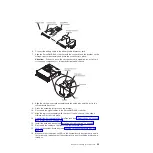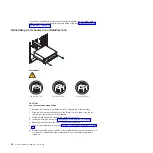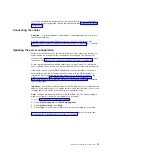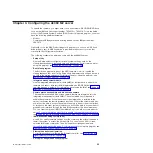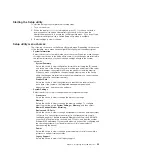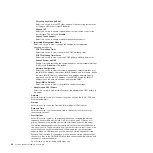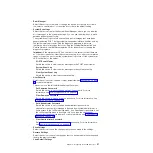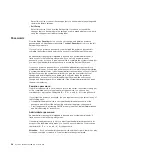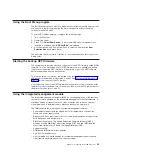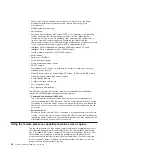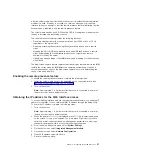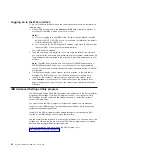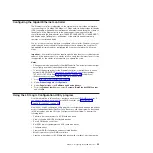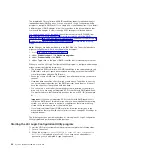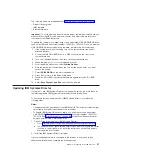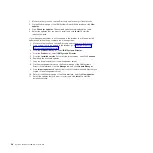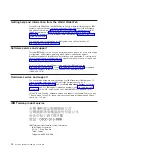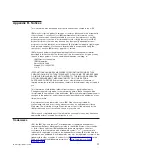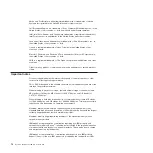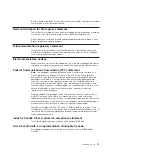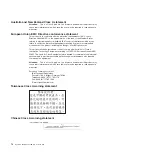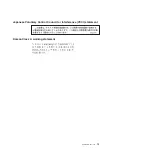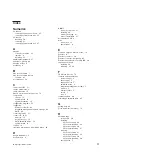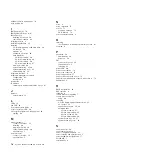
Configuring the Gigabit Ethernet controller
The Ethernet controller is integrated on the system board. It provides an interface
for connecting to a 10 Mbps, 100 Mbps, or 1 Gbps network and provides full-duplex
(FDX) capability, which enables simultaneous transmission and reception of data on
the network. If the Ethernet ports in the server support auto-negotiation, the
controller detects the data-transfer rate (10BASE-T, 100BASE-TX, or 1000BASE-T)
and duplex mode (full-duplex or half-duplex) of the network and automatically
operates at that rate and mode.
You do not have to set any jumpers or configure the controller. However, you must
install a device driver to enable the operating system to address the controller. To
find updated information about configuring the controller, complete the following
steps.
Important:
Some cluster solutions require specific code levels or coordinated code
updates. If the device is part of a cluster solution, verify that the latest level of code
is supported for the cluster solution before you update the code.
Notes:
v
Changes are made periodically to the IBM Web site. The actual procedure might
vary slightly from what is described in this document.
v
To install the device driver for the Ethernet controller, you might have to use an
external USB CD-RW/DVD drive such as the IBM and Lenovo part number
73P4515 or 73P4516. See “Firmware updates” on page 66 for additional
instructions about using an external USB CD-RW/DVD drive.
1. Go to http://www.ibm.com/systems/support/.
2. Under
Product support
, click
System x
.
3. Under
Popular links
, click
Software and device drivers
.
4. From the
Product family
menu, select
System x iDataPlex dx360 M2 server
and click
Go
.
Using the LSI Logic Configuration Utility program
Use the information in this section to configure an optional LSI RAID controller. If
you need to configure an optional ServeRAID controller, see “Configuring a
ServeRAID controller” on page 65.
Use the LSI Logic Configuration Utility program to configure and manage redundant
array of independent disks (RAID) arrays. Be sure to use the program as described
in this document. Use the LSI Logic Configuration Utility program to perform the
following tasks:
v
Perform a low-level format of a SCSI hard disk drive
v
View or change SCSI IDs for attached devices
v
Set a SCSI device scan order
v
Set SCSI protocol parameters on SCSI hard disk drives
v
Configure arrays
v
View your RAID configuration and associated devices
v
Monitor operation of your RAID controllers
v
Create a mirrored pair of SCSI hard disk drives with or without a hot-spare drive
Chapter 4. Configuring the dx360 M2 server
63
Summary of Contents for 6380
Page 1: ...System x iDataPlex dx360 M2 Types 6313 6380 6385 6386 7321 7323 7831 and 7834 User s Guide...
Page 2: ......
Page 3: ...System x iDataPlex dx360 M2 Types 6313 6380 6385 6386 7321 7323 7831 and 7834 User s Guide...
Page 7: ...Index 77 Contents v...
Page 8: ...vi System x iDataPlex dx360 M2 User s Guide...
Page 14: ...xii System x iDataPlex dx360 M2 User s Guide...
Page 66: ...52 System x iDataPlex dx360 M2 User s Guide...
Page 90: ...76 System x iDataPlex dx360 M2 User s Guide...
Page 94: ...80 System x iDataPlex dx360 M2 User s Guide...
Page 95: ......
Page 96: ...Part Number 90Y5680 Printed in USA 1P P N 90Y5680...

